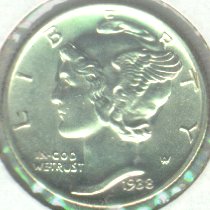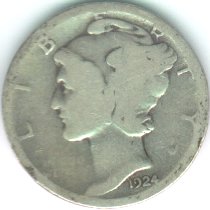| Grading
Coins
Grading coins is an art. Some would have you
believe that it is a science, but it is an art that
requires some skill. That being said, anyone with one
good eye can get a fairly good idea as to the
neighborhood of the grade of a coin. It's important to
know the grade of a coin because, in general, the
higher the grade of a coin, the higher its price.
Overview
American coins are most often graded these days on
a 70 point scale devised by Dr William Shelby for his
famous work, "Penny Whimsy" on early large
cents. 0 means that you can pretty much tell that it
was once a coin while 70 means that it is perfect.
Note that 60 is uncirculated, what the general public
would consider perfect, with no wear whatsoever. There
is a direct mapping from this scale to the older
descriptive terms, but they are not always used the
same. Ironically, the official numismatic organization
that varies the most from this scale is the EAC (Early
American Coppers) society. They tend to undergrade
coins with respect to the rest of the industry. The
other people that vary from the standard are
unscrupulous coin sellers that overgrade coins so that
they can sell coins for more money than they are
actually worth.
If you have absolutely no idea how to grade coins,
you have no business buying coins without help. If you
do not know how to grade coins for yourself, you will
eventually learn, and it could very well be an
expensive lesson. When selling coins, you don't have
as much of a problem. Simply take the coins to a
couple of different dealers and get their opinions as
to the grade. Always ask for the grade opinion before
asking for a price as it can help in negotiating a
fair price.
If you are interested in learning to grade coins
yourself, I would start with the excellent
"Official A.N.A. Grading Standards for United
States Coins" published by the ANA. For a very
quick overview, keep reading.
Getting In the
Ballpark
While determining an exact grade requires some
skill, getting a ballpark idea is within the realm of
everyone who can read this page.
Mint State (Unc) -
Absolutely no trace of wear.
Mint state coins vary from MS-60 to MS-70. As I
stated earlier, MS-70 is perfect. No blemishes, good
strike, great color, and a lot of other really nit
picky stuff. Trust me, any coin you have that isn't
slabbed isn't MS-70. It's like winning the lottery,
twice. An average shiny new penny from the supermarket
is MS-63. A really pretty one with no easily visible
marks is MS-65. If you have an average roll of new
cents from the supermarket, 2-5 will be MS-60, 5-15
will be MS-61, 25-40 will be MS-63, 5-8 will be MS-64
and 1-2 will be MS-65. If you are exceptionally lucky,
one will be MS-66. An MS-68 coin is one in 100,000!
Distinguishing the difference between these
uncirculated grades is where most of the black magic
in coin grading is. Even with years of experience,
coin dealers will disagree about these grades. Even
the professional grading services aren't 100%
consistent within these grade levels. Some coins are
very difficult case studies. European coin collectors
think that this American system of grading
uncirculated coins is just downright crazy.
Almost Uncirculated (AU)
- Small trace of wear visible on the highest points
AU coins come in AU-50, AU-55 and AU-58. As a
novice, you probably won't be able to tell the
difference between AU and Unc coins. I know I have
trouble a lot of the time. The most important thing in
grading an AU coin is to know is where the high points
are on a particular coin so that you can look for the
minimal wear there. Practice by taking a new coin from
the bank, rub it back and forth on your mouse pad
vigorously a few times, and see if you can see the
wear. Hold the coin nearly sideways in a bright light
so that the light reflects at a low angle off the
coin. Look for a difference in how the light reflects
from most of the coin versus the very highest points.
If it doesn't reflect off of the high points the same
way as it does from the rest of the coin, then you
probably have an AU coin. Note that most AU-58 coins
look much better than most MS-60 coins. One of the
weird things about coins is that an ugly uncirculated
coin often sells for more than a beautiful coin with
barely perceptible wear.
Extremely Fine (XF or EF)
- Very light wear on only the highest points.
XF coins come in XF-40 and XF-45. With an XF coin,
you can usually see the wear without messing around
too much, but it is a very small amount of wear. There
is often some of the mint luster left on the coin.
Most of the devices on the coin are clearly defined.
For each type of coin, there are different things to
look for in determining if a coin meets this demanding
grade.
Very Fine (VF) -
Light to medium wear. All major features are sharp.
VF coins come in VF-20, VF-25, VF-30 and
occasionally VF-35. The key word here is major. Minor
features such as some of the finer hair detail,
feathers, etc. will be worn. Take a roll of quarters
from the bank. Most of the coins from 1976-1983 or so
will likely grade VF. Personally, I specialize in VF
coins because they show most of the detail of the coin
and are a fraction of the cost of higher grade coins.
While they show honest wear, they are still very
attractive and detailed. Note that silver and copper
coins wear faster than clad coins, so VF probably
represents between 1-3 years of use.
Fine (F) - Moderate
to heavy even wear. Entire design clear and bold.
Fine is labelled F-12 in the Sheldon scale. Your
average 1965 quarter from circulation is Fine. A lot
of the details are gone, but you can still see a good
deal of the design.
Very Good (VG) -
Well worn. Design clear, but flat and lacking details.
Very Good is VG-8 on the Sheldon scale. The entire
design is weak, but a few details are visible. Full
rims are nearly always a requirement for this grade. A
full rim means that you can see a line around the edge
of the coin where it was raised up.
Good (G) - Heavily
worn. Design and legend visible but faint in spots.
On some coins, full rims are not required for this
grade. You must be able to read the date and mint
mark.
Almost Good (AG) -
Outlined design. Parts of date and legend worn smooth.
This is a used up coin. You should be able to make
out the date (possibly with some effort). Often, only
parts of the last two digits will be visible.
Fair (Fair) - You
can identify the coin as to its type.
There may be holes, it might be bent, or it might
just have a LOT of honest wear. You may or may not see
the date depending on the type and the nature of the
wear. Fair coins are also sometimes called
"filler" coins. That is because you can buy
them very cheaply to fill the holes in your
collection. Otherwise, you might never be able to
afford the coin. Many people collect fair condition
coins, especially the rarer dates and types. Dateless
buffalo nickels, for example, are still worth about a
dime. Some of the earlier type coins may be worth $50
or more in fair condition.
Basal State (Basal)
- You can identify the lump of metal as being a coin.
Basil state coins have extraordinarily low value. A
basil state large cent, for example, might sell for a
nickel.
Exceptions
Occasionally, you will find a poorly struck coin
that looks like it has wear, but is really
uncirculated. To see a good example of this, look at
the bottom of the shoulder of a new Lincoln cent. It
will always look like it has a little wear, but it is
just a problem with strike. While there is a premium
for well struck coins, the primary determination of
value is from wear. Some coins are nearly always
weakly struck. For example, early coins from New
Orleans often show weakness in striking. The reverse
of many seated dimes is often weakly struck, etc.
Coins with scratches, holes, very dark toning,
pitting, corrosion, fake color, retooling, repairs and
other problems are severely downgraded.
Sometimes you will see coins graded in in-between
numbers such as F-15 or VG-10 or VF/XF. There is
typically not very much of a premium for these
in-between grades, so in many cases they can represent
a good value.
Some early silver and gold coins have adjustment
marks. These do not effect the grade, but can affect
the value in a similar fashion.
Examples
There are many examples of coins in different
grades on the site. I would invite you to visit the for
sale pages to see pictures of coins in different
grades. In addition, I will soon put the grade of the
coins in the virtual type collection so that you can
compare there as well.
It is prohibitive at this point to have pictures of
all coin types in all grades on the web. But there are
CD-ROMs available with a full type set in all grades.
As an example, here
 Uncirculated
Uncirculated |
 Extra Fine
Extra Fine |
 Very Fine
Very Fine |
 Fine
Fine |
 Very Good
Very Good |
 Good
Good |
 About Good
About Good |
|
Net Grading
Net grading is a term used when referring to coins
that have problems. For example, a coin might have XF
wear, but have been scratched, corroded, cleaned, etc.
Often, such a coin will be given a "net"
grade, say VF reflecting the undesirable issues. This
is meant to reflect that while the coin may
technically grade XF, the market value should be
somewhere close to that of an average VF coin. While
completely problem free coins are the exception, net
grading is probably applied to less than a fourth of
the coins out there.
|